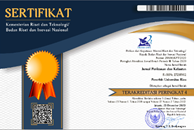The Technique of Directing the Sex of Betta Fish (Betta Sp.) Larval Stage (H3, H5, and H7) using Coconut Water (Cocos Nucifera)
(1) Universitas Lampung
(2) Jurusan Perikanan dan Kelautan, Fakultas Pertanian, Universitas Lampung
(3) Jurusan Perikanan dan Kelautan, Fakultas Pertanian, Universitas Lampung
(*) Corresponding Author
Abstract
Keywords
Full Text:
PDFReferences
Atmadjaja, J. (2009). Panduan lengkap memelihara Cupang Hias dan Cupang adu. Jakarta: Agromedia Pustaka.
Awaludin., D. Maulianawati, dan M. Adriansyah, M. 2019. Potensi Ekstrak Etanol Seledri (Apium graveolens) untuk Maskulinisasi Ikan Cupang (Betta sp). Jurnal Sumberdaya Akuatik Indopasifik, 3(2): 101-114.
Dwinanti, S.H., M. Hanggara, dan A. Putra. 2018. Pemanfaatan Air Kelapa (Cocos nucifera) untuk Maskulinisasi Ikan Guppy (Poicelia reticulata). Jurnal Akuakultur Rawa Indonesia, 6(2) : 117-122.
Dwinanti, S.H., dan M. Yusuf. 2019. Maskulinisasi Ikan Cupang (Betta splendens) Menggunakan Air Kelapa (Cocos nucifera) melalui Metode Perendaman Embrio. Prosiding Seminar Nasional, 1(3) : 978-979.
Fariz, M.Z.A. 2014. Pengaruh Konsentrasi Tepung Testis Sapi terhadap Maskulinisasi Ikan Cupang (Betta splendens). Skripsi. Fakultas Ilmu Kelautan dan Perikanan. Universitas Hasanuddin.
Fauzan, M., Sugihartono, dan M.A. Yusuf. 2018. Perbedaan Waktu Pemeliharaan Telur dan Larva oleh Induk Jantan terhadap Daya Tetas dan Kelangsungan Hidup Larva Ikan Cupang. Jurnal Akuakultur Sungai dan Danau, 3(3): 76-81.
Ferdian, A., Muslim, M. Fitrani. 2017. Maskulinisasi Ikan Cupang (Betta sp.) Menggunakan Ekstrak Akar Ginseng (Panax sp.). Jurnal Akuakultur Rawa Indonesia, 5(1):1-12.
Gemilang, B.R.I., F. Basuki, dan T. Yuniarti. 2016. Pengaruh Lama Waktu Pemberian Tepung Testis Sapi Terhadap Keberhasilan Menghasilkan Jantan Ikan Cupang (Betta sp.) Journal of Aquaculture Management and Technology, 5(1):124-129.
Hikmawandri., P. Ningsih, dan Ratnam. 2019. Penentuan Kadar Kalium (K) pada Air Kelapa Hijau (Cocos viridis) di Daerah Dolo dan Labuan Menggunakan Sprektofotometri. Jurnal Akademia Kimia, 8(1): 34-37.
Lithner, D., J. Damberg, G. Dave, dan A. Larsson. 2009. Leachates from Plastic consumer Product-screening for Toxicity with Daphnia magna. Chemosphere. Journal of Fisheries Research,74(3) : 1195-1200.
Masprawidinatra, D., Helmizuryani, dan Elfachmi. 2015. Pengaruh Penggunaan Air Kelapa dengan Lama Perendaman yang Berbeda Terhadap Maskulinisasi Ikan Nila (Oreochromis niloticus). Journal of Fisheries, 4(2): 13-16.
Phelps, R.P., dan T.J. Pompa. 2000. Sex Reversal of Tilapia Aquaculture in the Americas. Journal of The World Aquaculture Society, 2(2): 34-59.
Sari, A.N., dan D. Sustrami. 2018. Efektifitas Air Kelapa Hijau Muda terhadap Penurunan Tekanan Darah Tinggi pada Lansia di Posyandu Puskesmas Perak Timur Surabaya. Jurnal Ilmiah Kesehatan, 11(2) : 11-22.
Sarida, M., Tarsim, dan E. Barades. (2010). Penggunaan Madu dalam Produksi Ikan Guppy (Poecillia reticulata). Prosiding Forum Inovasi Teknologi Akuakultur, 4(2) :831-836.
Satyani, D. 2003. Pengaruh Umur Induk Ikan Cupang (Betta splenden regan) dan jenis Pakan terhadap Fekunditas dan Produksi Larvanya. Jurnal Penelitian Perikanan Indonesia, 1(2) : 13-18.
Siregar, S., M. Syaifudin, dan M. Wijayanti. (2018). Maskulinisasi Ikan Cupang (Betta splendens) Menggunakan Madu Alami Melalui Metode Perendaman. Jurnal Akuakultur Rawa Indonesia, 6(2) : 141- 152
Superyadi. 2017. Penggunaan Air Kelapa (Cocos nucifera) dengan Konsentrasi Berbeda untuk Maskulinisasi Ikan Cupang(Bettasplendens). Skripsi. Palembang : Universitas Sriwijaya.
Yusuf, A., K. Yuniarti, dan M. Ade. (2015). Pengaruh Perbedaan Tingkat Pemberian Pakan Jentik Nyamuk terhadap Pertumbuhan Benih Ikan Cupang. Jurnal Ilmiah Perikanan dan Kelautan, 2(2) : 23-42.
Zairin, M. 2002. Sex Reversal : Memproduksi Benih Ikan Jantan atau Betina. Jakarta : Penebar Swadaya : 95 hlm.
Article Metrics
Abstract view : 271 timesPDF - 254 times
DOI: http://dx.doi.org/10.31258/jpk.26.3.185-191
Copyright (c) 2021 Jurnal Perikanan dan Kelautan

This work is licensed under a Creative Commons Attribution-NonCommercial-NoDerivatives 4.0 International License.
Gedung Marine Center Lt 2. Fakultas Perikanan dan Kelautan Universitas Riau



